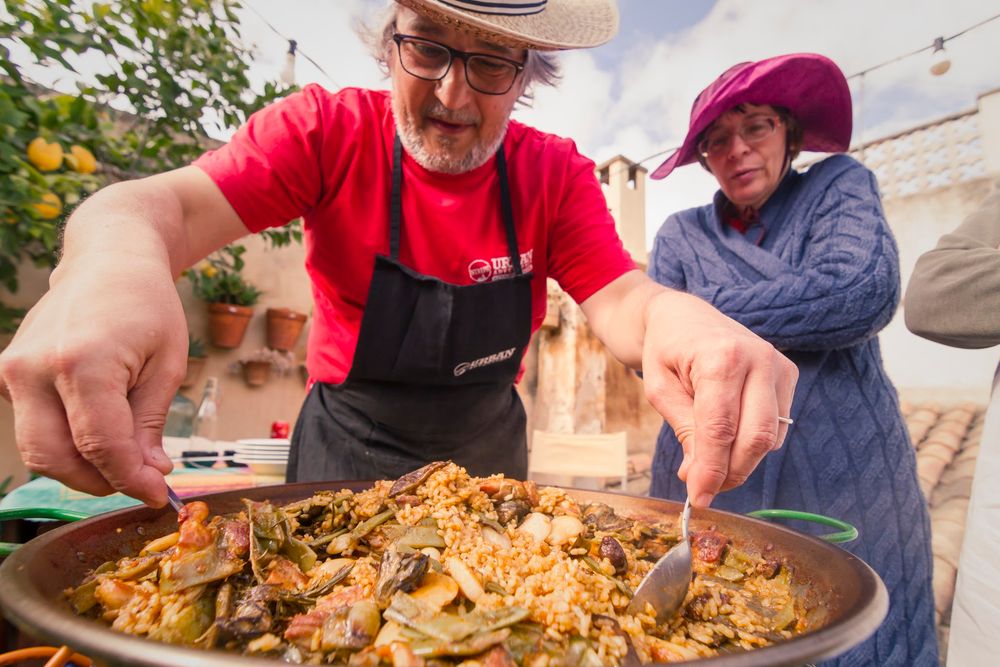
Not all paellas are created the same. We asked local Mallorca paella chef Ramón Cifuentes how to tell the awesome from the awful.
If you’re planning to visit our island of Mallorca, no doubt you’ll want to enjoy the local gastronomy. And, of course, a must-try is the most popular dish of the Mediterranean coast: paella. The fame of rice cooked in a paella pan is well deserved. Humble rice achieves its maximum level of texture and flavour in the various forms of paella, from a classic Valenciana Paella with meat and vegetables, to a seafood paella to a vegetable paella.
But not all that glitters, round and shiny like the sun, is gold. Because of the popularity of paella among both locals and foreigners, the number of restaurants serving disappointing paella have mushroomed in many touristy areas. Simply being born in the land of paella does not necessarily mean being a good paella chef. The paella technique is not in the DNA: acquiring it takes learning, dedication and respect to tradition and gastronomic culture.
So, before you visit, make sure you know how to tell a good paella from a bad paella. A delicious paella is not the same as just some rice cooked with stuff, so we have a few clues that will help you find the paella you deserve.
Flee, as if it were the plague, from the extremely yellow paellas, shiny like a truck headlight. They have been coloured with tartrazine [E-102 (UE); Yellow 5 (FDA-USA)], which is not very healthy and brings no flavours or aromas, only colour. Respect for both the dish and guests requires the use of saffron. Once properly toasted and dissolved, saffron will give a paella a ochre-orange hue that locals recognise, and a subtle aroma the we appreciate so much.

Hard at work, researching good and bad paellas | Photo by Mallorca Urban Adventures
Disappear if you are served a paella simulation that has been cooked in something that is not a wide, steel frying pan with handles at the side and very little depth, like a boiling pan or a clay pot. These shallow pans are called paella, hence the name of the dish, and are necessary for getting a thin layer of rice that is not sticky. If you are served a paella that is thicker than a centimetre, run away!
Get away, as fast as you can, from pre-cooked paellas: an invasive trend on our coasts. Some brands will actually provide an okay product, but if you go to a restaurant, you should have it freshly cooked by an expert chef following the ritual that guarantees its excellence using fresh and local ingredients.
Escape without a doubt, unless it has been cooked in front of you, huge paellas that some restaurants serve as guests are seated. Each paella should be cooked in a pan with the right diameter for the number of guests right before it’s served.

You can spot a bad paella because the grains don’t fall one by one, but in a clump | Photo by Mallorca Urban Adventures
Dodge all paellas saturated with ingredients, where you can hardly see the rice under a surface full of ingredients. You should particularly avoid the infamous “Paella Mixta” with meat and fish, which was invented for tourists. And run, as if a group of wolves wanted to get you, if you witness a paella with onion, chorizo or fried eggs… Rice is the main actor and it only accepts the presence of a co-protagonist, like meat or seafood, and one or two secondary actors: some vegetables, beans, prawns… Many flavours can be used in a paella, but not all at once!
And especially escape, as if your life were at risk, from a rice that is soft, sticky or wet. In a perfect paella, rice should by dry, al dente, flavorful and not sticky.

This Valentian paella has the right consistency | Photo by Mallorca Urban Adventures
To sum up, always choose the paellas that are specially made for you and your friends/family (even though it means you’ll have to wait a bit). Look for a wide paella pan and fresh, local products. You should expect a thin layer of rice with natural colours and a simple combination of ingredients. The rice grain should not be sticky: they fall off your fork one by one (or in small groups) instead of falling in big, pasty chunks. Once in your mouth, the rice grains of a good paella will feel soft on the outside and harder on the inside, which means they have been cooked to the right point, and flavourful.
But what locals really enjoy about a paella isn’t just the food itself, but the celebration that comes with it, cooking and eating a paella at home, with friends, the traditional way and outdoors. This is particularly true for the cook, who should receive well-deserved compliments from friends and family.
I once tasted a mixed paella. That experience changed my life. As a mission, I chose to improve my skills to cook paella as I would like others to cook it for me, to share the good practices as a public service and to fight the dark (or excessively shiny yellow) side of paella.